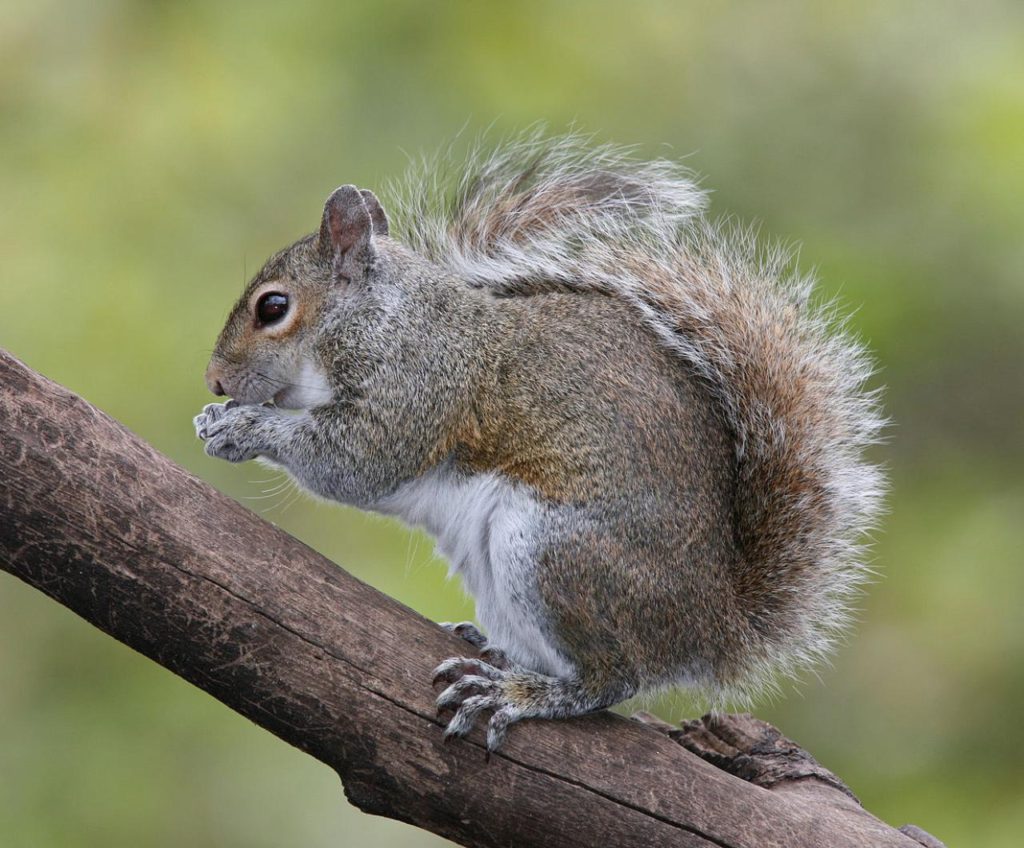The world is full of wonderful squirrels: Pattertwig in C.S. Lewis’s Prince Caspian, Silent Sam and Jess Squirrel in Brian Jacques’s Redwall, Scrat, the acorn-chasing squirrel in the Ice Age movies. Check out the resources below for all things squirrel, including squirrel poems, squirrel paintings, squirrel robots, and a peculiar purple squirrel from Pennsylvania.
Table of Contents
SQUIRREL STORIES: GOOD SQUIRRELS
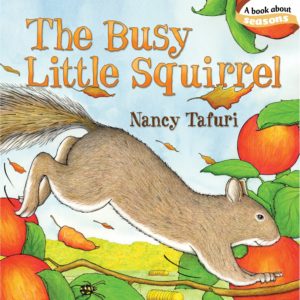
|
In Nancy Tafuri’s The Busy Little Squirrel (Simon & Schuster Books for Young Readers, 2007), fall has arrived and a frenetic squirrel busily gathers nuts, berries, and apples, and prepares his nest for winter. He’s too busy to nibble pumpkin with the mice, hop rocks with the frogs, or run in the fields with the dogs – and finally, when asked to watch the moon with the owls, tired (but well-stocked) squirrel is fast asleep. For ages 3-6. |
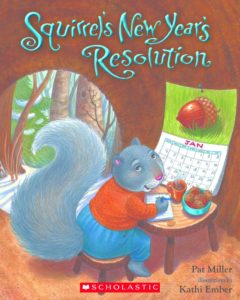
|
In Pat Miller’s Squirrel’s New Year’s Resolution (Albert Whitman & Company, 2010), it’s New Year’s Day according to the Nut-of-the-Month calendar and Squirrel struggles to make a resolution, having learned from Bear, the helpful librarian, that a resolution is “a promise you make to yourself to be better or to help others.” In search of a resolution, puzzled Squirrel visits friends Skunk, Mole, Turtle, and Porcupine, giving each a helping hand along the way; in the end she discovers that her actions show that she’s already fulfilling a resolution. For ages 4-6. |
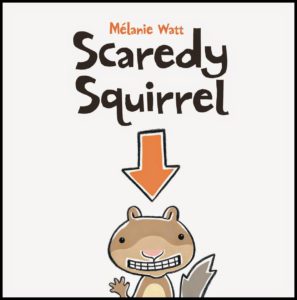
|
The panic-stricken protagonist of Melanie Watts’s Scaredy Squirrel (Kids Can Press, 2008) refuses to leave his tree. Anything could be out there in the fearsome unknown – Martians, sharks, tarantulas, germs. And he’s well-prepared for threats with an emergency kit containing everything from antibacterial soap to a parachute. Then one day, terrified by passing (killer?) bees, he leaps from his tree – and discovers, to his amazement, that he’s not just a squirrel: he’s a flying squirrel. There are many sequels, in which Scaredy Squirrel variously fears rabbits, piranhas, jellyfish, falling coconuts, dragons, ghosts, bats, confetti, ponies, and Bigfoot. For ages 4-8. |
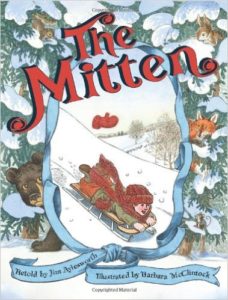
|
In Jim Aylesworth’s wonderful retelling of The Mitten (Scholastic, 2009), based on a Ukrainian folktale, a little boy goes out to play in the snow, bundled in a knitted red-wool hat, scarf, and pair of mittens – one of which he loses after a sled ride down the hill. A cold little squirrel finds the lost mitten and curls up inside to get warm; next a cold rabbit arrives, begging to come in too. Animal after animal stuffs itself into the expanding mitten until finally a little mouse is the last straw: the mitten bursts, leaving behind a scattered pile of yarn. At the end of the book, the grandmother is knitting the boy a new mitten. For ages 4-8. |
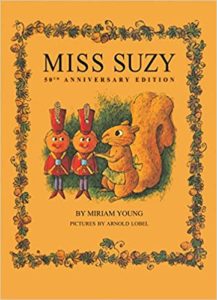
|
Miriam Young’s Miss Suzy (Purple House Press, 2004), originally published in 1964, is the story of a sweet and highly domestic gray squirrel – she’s a whiz with acorn pudding – who is tossed out of her cozy tree by a gang of delinquent red squirrels. She shelters in the attic of the house next door, where she finds old dollhouse and a box of toy soldiers. The toy soldiers come to life and soon adore Miss Suzy, who settles them in the dollhouse, cooks for them, and tucks them into bed every night. Eventually they help her return home and drive the red squirrels from her tree. For ages 4-8. |
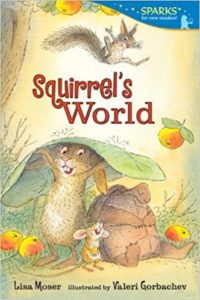
|
Lisa Moser’s Squirrel’s World (Candlewick, 2007) is a short chapter book for beginning readers, in which enthusiastic and well-meaning Squirrel wants only to help his friends, but his manic efforts always seem to backfire. For ages 4-8. |
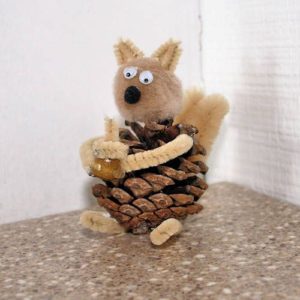
|
Kids’ Wings: Squirrel’s World has activities and information to accompany Squirrel’s World, including a squirrel origami pattern, a peanut-burying project (see if you can find them a week later), a pinecone squirrel craft, and instructions for a game of “Nutty Squirrels,” in which players guess which egg-carton-cup squirrel is hiding the nut. |
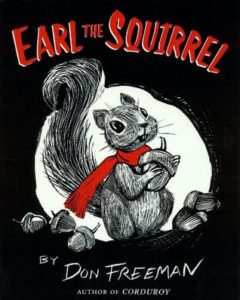
|
Earl of Don Freeman’s Earl the Squirrel (Puffin, 2007) has been told by his mother that it’s high time he learned to gather his own acorns, so off he goes to visit Jill, the little girl next door, who gives him a nut and a nutcracker. His mother is appalled – no squirrel needs a nutcracker – and makes him take it back. Jill then gives him a red scarf to keep his ears warm, which doesn’t please his mother either – furry squirrels don’t need scarves. Earl, now determined to prove himself and make his mother proud, sets out to find acorns – but his red scarf turns out to be a problem when he encounters Conrad the bull. For ages 4-8. |
| See Teaching Children Philosophy for background information and philosophical discussion questions for Earl the Squirrel, variously categorized under “Independence,” “Dependence on Technology,” and “Risk vs. Reward.” | |
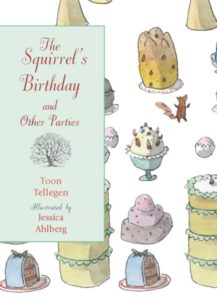
|
Toon Tellegen’s The Squirrel’s Birthday and Other Parties (Boxer Books, 2009), with wonderful illustrations by Jessica Ahlberg, is a magical collection of nine animal stories. In the first of these, Squirrel – who lives in a house plastered with sticky notes – finds one reminding him of his upcoming birthday. He promptly invites all his friends, and then devotes himself to baking a marvelous array of cakes: huge honey cakes for the bear and the bumblebee, a grass cake for the hippo, and a cake made of water for the dragonfly, “a strange, gleaming cake and he put it to one side under the twigs of the rosebush.” A lovely book for ages 5 and up. |
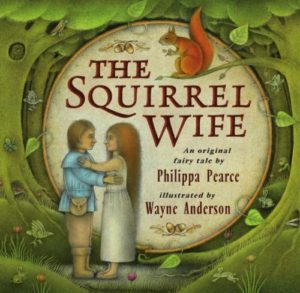
|
In Philippa Pearce’s green-drenched The Squirrel Wife (Candlewick, 2007), the young swineherd Jack – despite the protests of his wicked older brother – ventures into the forest on a stormy night and rescues one of its resident magical green people, a man trapped under a fallen tree. As a reward, the green man gives Jack a golden ring that turns a squirrel into a lovely wood-wise woman who becomes his wife. They live happily in the forest until Jack’s brother, jealous, accuses Jack of theft and has him imprisoned; and to rescue him, the squirrel wife must make a heartbreaking choice. For ages 5-9. |
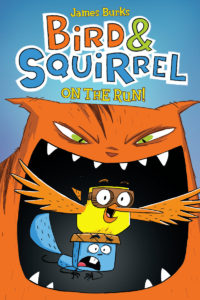
|
In James Burks’s graphic novel Bird & Squirrel on the Run (Scholastic/Graphix, 2012), Bird and Squirrel are an unlikely duo: Bird is a happy-go-lucky free spirit, while Squirrel, who never takes off his acorn helmet, is nervous and obsessive (“New things give me stomachaches”). Both are in danger from Cat, a toothy orange monster who would like nothing better than to eat them both. When Squirrel’s winter food supply is destroyed, Bird and Squirrel head south, forging a friendship, foiling a cat, and developing a taste for adventure along the way. For ages 7-10. |
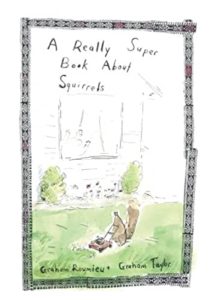 |
By Graham Taylor and Graham Roumieu, A Really Super Book About Squirrels (Andrews McMeel, 2003) is a clever and extremely funny tale of a neighborhood squirrel (“Oh squirrel/We live so close/Yet we cannot be friends”), with irresistible ink-and-watercolor illustrations. For all ages. |
SQUIRREL STORIES: BAD SQUIRRELS
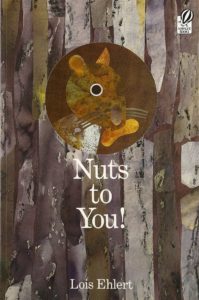 |
In Lois Ehlert’s Nuts to You (Sandpiper, 2004), illustrated with gorgeous paper collages, a feisty city squirrel digs up the flowerpots, steals seeds from the birdfeeder, and sneaks through a hole in the window screen into a little boy’s apartment bedroom. For ages 3-6. |
| Teach Preschool’s Nuts About Acorns pairs a reading of Nuts to You with activities in which kids estimate numbers of acorns and make acorn shaker bottles. | |
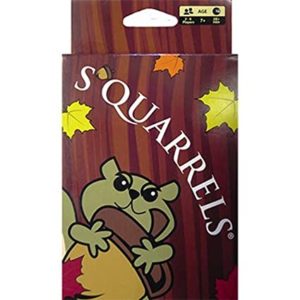
|
S’Quarrels (Home Lantern Games) is a fast-paced family-friendly card game in which players (squirrels) compete to collect the most acorns before the onset of Winter ends the game. In the process, they cope with Quarrels, Ambushes, and Whirlwinds, and try to avoid the dreaded Rotten Acorn. Suggested for 2 to 6 players, ages 6 and up. |
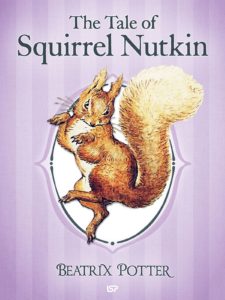
|
In Beatrix Potter’s The Tale of Squirrel Nutkin (Frederick Warne, 2012), originally published in 1903, Nutkin – a mischievous pest with a taste for rhyming riddles – goes too far with grouchy owl Old Brown and loses a chunk of his tail. |
| Read The Tale of Squirrel Nutkin with the original Potter illustrations online. | |
 |
Loud Crow Interactive’s Pop Out! The Tale of Squirrel Nutkin is a wonderful 50-page interactive app in which Potter’s illustrations pop out of the page when touched or slide on tabs, along with animations and an audio background of chattering squirrels and growly owl. Also see Loud Crow’s terrific Pop Out! The Tale of Peter Rabbit. |
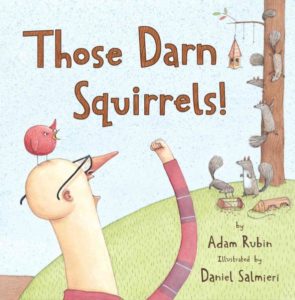
|
Adam Rubin’s hilarious and delightful Those Darn Squirrels! (Sandpiper, 2011) features the unspeakably grumpy Old Man Fookwire, who hates pies and puppies – but loves birds. He paints bird portraits and fills his yard with beautiful birdfeeders, in hopes of persuading his beloved birds stay with him through the winter. The feeders promptly attract a gang of particularly persistent and innovative squirrels (they’re good with pulleys and catapults). When the birds do fly south, leaving Old Man Fookwire alone in his house mournfully eating cottage cheese, the squirrels decide to do him a good turn in payment for all the goodies they’ve nabbed. Sequels include Those Darn Squirrels Fly South and Those Darn Squirrels and the Cat Next Door. For ages 4-8. |
| Watch clever squirrels navigate an obstacle course. | |
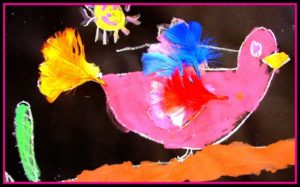 |
Inspired by Old Man Fookwire? From Deep Space Sparkle Art Lessons for Kids, see How to Draw a Bird for a great bird drawing, painting, and decorating project. Make beautiful bird portraits of your own. |
| For more resources, see Birds. | |
| From Artists Helping Children, Easy Birdfeeders, House, and Perches has instructions and patterns for several different kinds of bird feeders and bird snacks, among them pinecone, soda bottle, and milk carton feeders. Also included: a recipe for bird biscuits. Squirrels, of course, like these too. | |
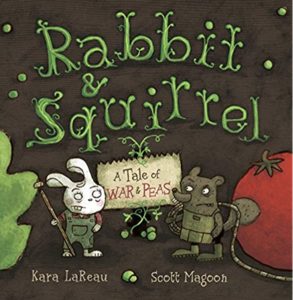
|
The title characters of Kara LaReau’s Rabbit & Squirrel: A Tale of War and Peas (Harcourt Children’s Books, 2008) are neighbors, but not friends. When vegetables begin to disappear from their adjacent gardens, each blames the other. Squirrel hurls a rotten tomato at Rabbit; Rabbit turns the hose on Squirrel. Finally a huge human being – to whom, it becomes clear, the garden actually belongs – chases both Rabbit and Squirrel into the woods, where they stubbornly continue their battle. A lesson in how not to cope with conflict. For ages 4-8. |
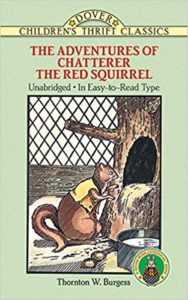
|
Naturalist Thornton Burgess wrote many nature-based books for children, beginning in 1910 with the publication of Old Mother West Wind. The stories are set in the Green Forest and star a vast cast of animal characters, among them Peter Rabbit, Jimmy Skunk, Sammy Jay, Reddy Fox, and Little Joe Otter. In The Adventures of Chatterer the Squirrel (Dover Publications, 1992), Chatterer – a thoroughly mischievous red squirrel – has a narrow escape from Shadow the Weasel (never tease a weasel) and a lucky escape from Farmer Brown’s boy who captures him (he was in the corn crib pinching corn) and puts him in a cage. A chapter book for ages 5-9. |
| Read The Adventures of Chatterer the Squirrel online. | |
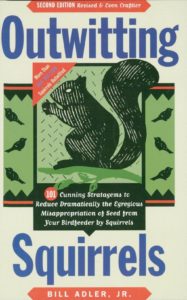
|
Bill Adler’s Outwitting Squirrels (Chicago Review Press, 1993) is filled with squirrel stories, squirrel facts, and helpful strategies for keeping squirrels out of your birdfeeder. It’s also a hoot to read. Sample chapter titles include “Know the Enemy,” “The Unbearable Persistence of Squirrel Appetite,” and “What to Do if You Think Squirrels Are Cute.” A great resource for the squirrel-afflicted adult. |
